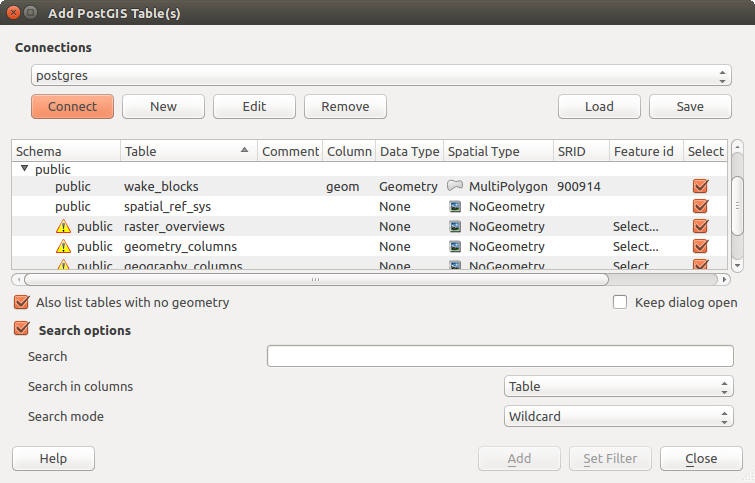` `
データを開く¶
オープンソース・ソフトウェアのエコシステムの一環として、QGISは、独自のプロバイダーと組み合わせて、提供機能が読み込まれ、多くの場合、フォーマットの多くを書くための異なるライブラリーに基づいて構築されています。
- Vector data formats include ESRI formats (shapefiles, geodatabases...), MapInfo and MicroStation file formats, AutoCAD DWG/DXF, GeoPackage, GeoJSON, GRASS, GPX, KML, Comma Separated Values, and many more... Read the complete list of OGR vector supported formats;
- Raster data formats include ArcInfo Binary Grid, ArcInfo ASCII Grid, JPEG, GeoTIFF, ERDAS IMAGINE, MBTiles, R or Idrisi rasters, ASCII Gridded XYZ, GDAL Virtual, SRTM, Sentinel Data, and many more... Read the complete list of raster supported formats;
- Database formats include PostgreSQL/PostGIS, SQLite/SpatiaLite, Oracle, DB2 or MSSQL Spatial, MySQL...;
- Support of web data services (WM(T)S, WFS, WCS, CSW, ArcGIS Servers...) is also handled by QGIS providers (see OGCデータクライアントとしてのQGIS);
また、アーカイブフォルダからサポートされたファイルを読み込むと、このような仮想およびメモリレイヤーとしてQGISのネイティブフォーマットを使用できます。
As of the date of this document, more than 80 vector and 140 raster formats are supported by the GDAL/OGR and QGIS native providers.
ノート
リストに含まれるフォーマットは、様々な理由から、すべてはQGISで動作しないかもしれません。例えば、いくつかは、外部の独自のライブラリを必要としたり、ご使用のOSの GDAL/OGR のインストールが使用したい形式をサポートするように構築されていない可能性があります。利用可能なフォーマットのリストを得るには、コマンドライン ogrinfo--formats を実行する(ベクター用)、またはQGISで 設定 ‣ オプション ‣ GDAL メニューを確認します(ラスター用)。
ブラウザパネル¶
QGIS Browser is one of the main panels of QGIS that lets you quickly and easily add your data to projects. It helps you navigate in your filesystem and manage geodata, regardless the type of layer (raster, vector, table), or the datasource format (plain or compressed files, database, web services).
To add a layer into a project:
- right-click on QGIS toolbar and check
 Browser Panel
to activate it or select it from the menu View ‣ Panels
(or
Browser Panel
to activate it or select it from the menu View ‣ Panels
(or  Settings ‣ Panels);
Settings ‣ Panels); - a browser tree with your filesystem, databases and web services is displayed;
- find the layer in the list;
- right-click on its name and select Add selected layer(s). Your layer is now added to the Layers Panel and can be viewed in the map canvas.
ノート
You can also add a layer or open a QGIS project directly from the Browser panel by double-clicking its name or by drag-and-drop into the map canvas.
ファイルがロードされたら、地図のナビゲーションツールを使用して、それを中心にズームできます。レイヤーのスタイルを変更するには、レイヤー名上ダブルクリックするか、または凡例の名前を右クリックしてコンテキストメニューから プロパティ を選択することで、 レイヤープロパティ ダイアログを開きます。ベクターレイヤーのシンボルの設定の詳細は、 Style Properties セクションを参照。
パネルの上部には幾つかのアイコンがあり、あなたの助けになります:
 選択レイヤーを追加 項目:また、レイヤーのコンテキストメニューから 選択したレイヤー(複数可)を追加 を選択することで、地図キャンバスにデータを追加できます。
選択レイヤーを追加 項目:また、レイヤーのコンテキストメニューから 選択したレイヤー(複数可)を追加 を選択することで、地図キャンバスにデータを追加できます。 フィルタブラウザ 特定のデータを検索します。検索ワードまたはワイルドカードを入力して、ブラウザがDBテーブル、ファイル名やフォルダをマッチングするだけショーのパスにツリーをフィルタリングします - 他のデータやフォルダは表示されません。 figure_browser_panels 上のブラウザパネル(2)の例を参照してください。比較では、大文字と小文字は区別であってもなくてもよいです。また、に設定できます。
フィルタブラウザ 特定のデータを検索します。検索ワードまたはワイルドカードを入力して、ブラウザがDBテーブル、ファイル名やフォルダをマッチングするだけショーのパスにツリーをフィルタリングします - 他のデータやフォルダは表示されません。 figure_browser_panels 上のブラウザパネル(2)の例を参照してください。比較では、大文字と小文字は区別であってもなくてもよいです。また、に設定できます。通常 :検索テキストを含む任意の項目を返します
ワイルドカード(複数可) を使用: ? および/または * 文字を使用して検索を微調整し、検索テキストの位置を指定します
正規表現 を使用して
 Enable/disable properties widget: when toggled on,
a new widget is added at the bottom of the panel showing, if applicable,
metadatas of the selected item.
Enable/disable properties widget: when toggled on,
a new widget is added at the bottom of the panel showing, if applicable,
metadatas of the selected item.
ブラウザツリー内の項目を右クリックし、次のことに役立ちます。
ファイルまたはテーブルの場合には、そのメタデータを表示したり、プロジェクトで開きます。テーブルは、名前変更、削除または切り捨てもできます;
フォルダの場合は、お気に入りにそれをブックマークし、ブラウザツリーからそれを隠します。隠しフォルダは 設定 ‣ オプション ‣ データソース タブから管理できます:
データベースやWebサーバーへの接続を作成します。
スキーマを更新し、名前の変更または削除。
簡単なドラッグアンドドロップで、データベースにファイルをインポートしたり、あるスキーマ/データベースから別のものにテーブルをコピーしたりもできます。ドラッグ中に長いスクロールをしなくてよいよう、利用可能な2番目のブラウザパネルがあります。ファイルを選択し、あるパネルから他へドラッグアンドドロップするだけです。
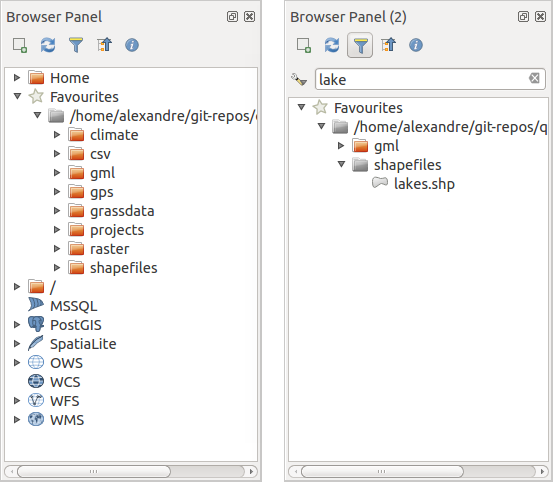
横並びのQGISブラウザパネル
ちなみに
お使いのOSのファイルブラウザからの簡単なドラッグ&ドロップでQGISにレイヤーを追加します
ファイルをプロジェクトに追加するには、オペレーティングシステムのファイルブラウザから レイヤーパネル または地図キャンバスにファイルをドラッグアンドドロップします。
DBマネージャ¶
DBマネージャ プラグインは、QGIS(PostGIS、SpatiaLite、GeoPackage、Oracle Spatial、MSSQL、DB2、Virtual layers)でサポートされている空間データベースフォーマットを1つのユーザーインターフェイスで統合して管理するための主要なツールです。 プラグイン ‣ プラグインの管理とインストール... メニューから起動できます。
データベースに接続し、その構造と内容を表示します。
データベースのプレビューテーブル。
いずれかをダブルクリックするか、ドラッグ・アンド・ドロップで、地図キャンバスにレイヤーを追加します。
QGISのブラウザから、または別のデータベースからデータベースにレイヤーを追加します。
地図キャンバスにSQLクエリの出力を作成し追加します。
virtual layers を作成します。
DBマネージャの機能の詳細については、 DB マネージャプラグイン で公開されています。
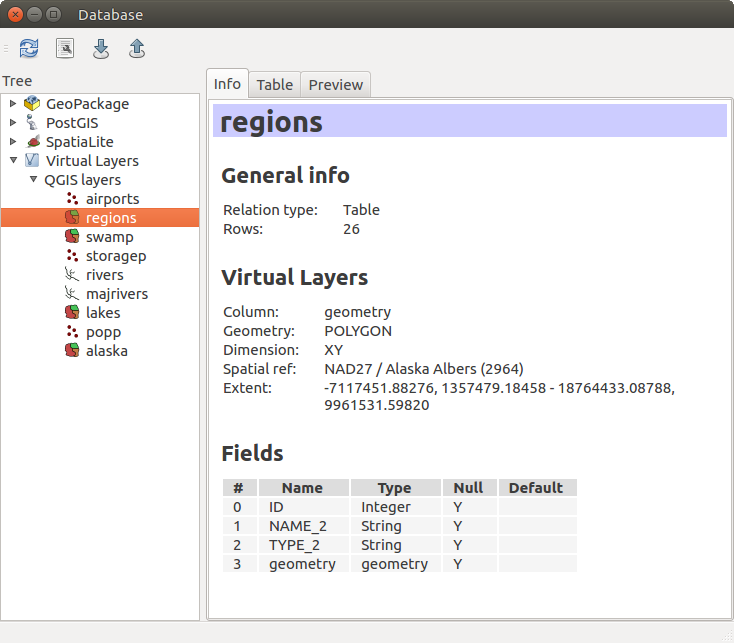
[DBマネージャ]ダイアログ
プロバイダーベースのロードツール¶
QGISがフォーマットに関係なくレイヤーを追加するために提供する主なツールであるブラウザパネルとDBマネージャのほかに、データプロバイダー固有のツールもあります。
ノート
外部プラグイン にはQGISで特定のフォーマットファイルを開くためのツールも提案するものがあります。
ファイルからレイヤーを読み込む¶
ファイルからレイヤーを読み込むには:
for vector data (like Shapefile, Mapinfo or dxf layer), click on
 Add Vector Layer toolbar button, select the
Layer ‣ Add Layer ‣
Add Vector Layer toolbar button, select the
Layer ‣ Add Layer ‣  Add Vector
Layer menu option or press Ctrl+Shift+V.
This will bring up a new window (see figure_vector_add) from which you can
check
Add Vector
Layer menu option or press Ctrl+Shift+V.
This will bring up a new window (see figure_vector_add) from which you can
check  File and click on [Browse]. You can
also specify the encoding for the file if desired.
File and click on [Browse]. You can
also specify the encoding for the file if desired.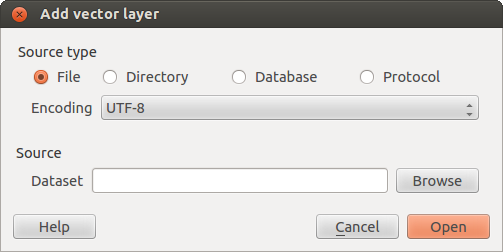
ベクターレイヤーダイアログを追加
ラスターレイヤーの場合は、
 ラスターレイヤーを追加 アイコンをクリックし、 レイヤー ‣ レイヤーを追加 ‣
ラスターレイヤーを追加 アイコンをクリックし、 レイヤー ‣ レイヤーを追加 ‣  ラスターレイヤーを追加 メニューオプションを選択するか、または Ctrlキー+Shiftキー+R をキーボード入力します。
ラスターレイヤーを追加 メニューオプションを選択するか、または Ctrlキー+Shiftキー+R をキーボード入力します。
これにより、ファイルシステムをナビゲートし、シェープファイル、geotiff、またはその他のサポートされているデータソースを読み込むことができる標準の[ファイルを開く]ダイアログ( figure_vector_open 参照)が表示されます。選択ボックス フィルタ  サポートされているファイル形式をあらかじめ選択できます。十分テストされている形式だけがリストに表示されます。 すべてのファイル(*.*) を選択することで、未テストの他のフォーマットを読み込むことができます。
サポートされているファイル形式をあらかじめ選択できます。十分テストされている形式だけがリストに表示されます。 すべてのファイル(*.*) を選択することで、未テストの他のフォーマットを読み込むことができます。
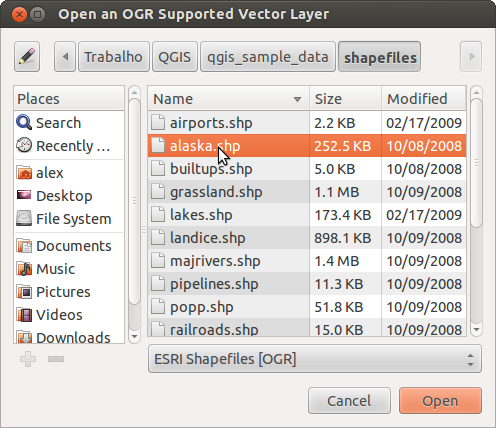
OGRサポートベクタレイヤーダイアログを開きます。
Selecting a file from the list and clicking [Open] loads it into QGIS. More than one layer can be loaded at the same time by holding down the Ctrl or Shift key and clicking on multiple items in the dialog. Figure_vector_loaded shows QGIS after loading the alaska.shp file.
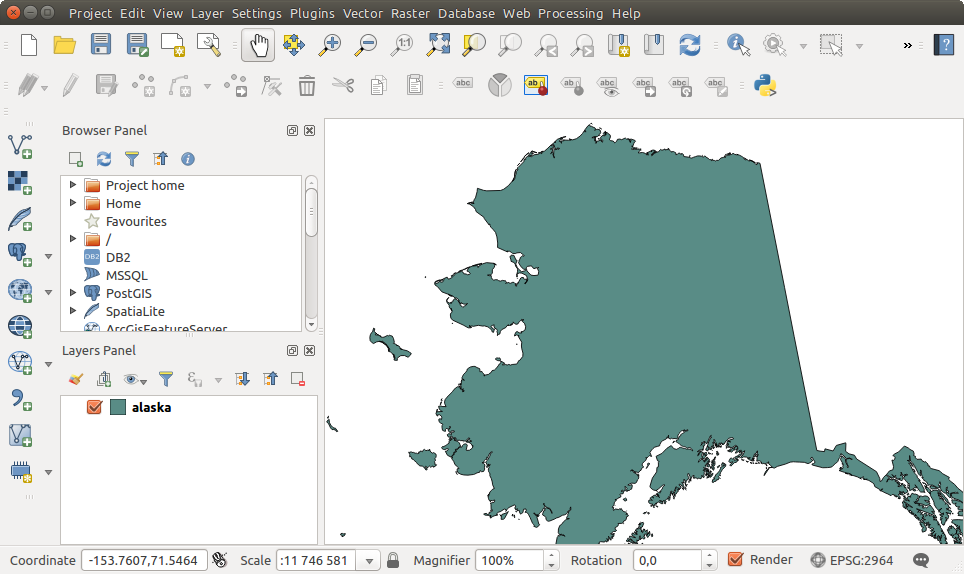
アラスカのシェープファイルがロードされたQGIS
ノート
MapInfo(例えば、 .tab )やAutocad( .dxf )のようないくつかのフォーマットは、1つのファイルに異なるタイプのジオメトリを混在させることができるので、QGISでそのようなフォーマットをロードすると、レイヤーあたり1つのジオメトリとするために使用するダイアログが開きます。
Using the  Add Vector Layer tool:
Add Vector Layer tool:
You can also load specific formats like ArcInfo Binary Coverage, UK. National Transfer Format, as well as the raw TIGER format of the US Census Bureau or OpenfileGDB. To do that, you’d need to select
 Directory as Source type. In this case
a directory can be selected in the dialog after pressing [Browse].
Directory as Source type. In this case
a directory can be selected in the dialog after pressing [Browse].With the
 Database source type you can select an
existing database connection or create one to the selected database type.
Available database types are ODBC, OGDI Vectors, Esri Personal
Geodatabase, MySQL as well as PostgreSQL or MSSQL.
Database source type you can select an
existing database connection or create one to the selected database type.
Available database types are ODBC, OGDI Vectors, Esri Personal
Geodatabase, MySQL as well as PostgreSQL or MSSQL.Pressing the [New] button opens the Create a New OGR Database Connection dialog whose parameters are among the ones you can find in ストアドコネクションを作成する. Pressing [Open] you can select from the available tables for example of the PostGIS enabled database.
The last source type,
 Protocol, enables to open
data from the web using for example GeoJSON or CouchDB format. After
selecting the type you have to fill URI of the source.
Protocol, enables to open
data from the web using for example GeoJSON or CouchDB format. After
selecting the type you have to fill URI of the source.
ちなみに
macOSで外部ドライブからレイヤーとプロジェクトをロードする
On macOS, portable drives that are mounted beside the primary hard drive do not show up as expected under File ‣ Open Project. We are working on a more macOS-native open/save dialog to fix this. As a workaround, you can type /Volumes in the File name box and press Enter. Then you can navigate to external drives and network mounts.
区切りテキストファイルをインポートする¶
Delimited text file (e.g. .csv, .txt) can be loaded in QGIS
using the tools described above. However, loaded this way, it’ll show up like a
simple table data. Sometimes, delimited text files can contain geometric data
you’d want to visualize; this is what the  Add
Delimited Text Layer is designed for.
Add
Delimited Text Layer is designed for.
Click the toolbar icon  Add Delimited Text Layer in the
Manage layers toolbar to open the Create a Layer from a
Delimited Text File dialog, as shown in figure_delimited_text.
Add Delimited Text Layer in the
Manage layers toolbar to open the Create a Layer from a
Delimited Text File dialog, as shown in figure_delimited_text.

区切りテキストダイアログ
First, select the file to import (e.g., qgis_sample_data/csv/elevp.csv) by clicking on the [Browse] button. Once the file is selected, QGIS attempts to parse the file with the most recently used delimiter. To enable QGIS to properly parse the file, it is important to select the correct delimiter. You can specify a delimiter by activating:
 CSV (comma separated values);
CSV (comma separated values); カスタム区切り文字,、 コンマ 、 スペース 、 タブ 、 セミコロン ... ...のような、あらかじめ定義された区切り文字の中から選択します。
カスタム区切り文字,、 コンマ 、 スペース 、 タブ 、 セミコロン ... ...のような、あらかじめ定義された区切り文字の中から選択します。または
 正規表現の区切り文字 と 式 フィールドにテキストを入力します。たとえば、区切り文字をタブに変更するには、 \t (これはタブ文字の正規表現です)を使用します。
正規表現の区切り文字 と 式 フィールドにテキストを入力します。たとえば、区切り文字をタブに変更するには、 \t (これはタブ文字の正規表現です)を使用します。
Once the file is parsed, set Geometry definition to
 Point coordinates and choose the X and Y
fields from the dropdown lists. If the coordinates are defined as
degrees/minutes/seconds, activate the
Point coordinates and choose the X and Y
fields from the dropdown lists. If the coordinates are defined as
degrees/minutes/seconds, activate the  DMS coordinates
checkbox.
DMS coordinates
checkbox.
Finally, enter a layer name (e.g., elevp), as shown in figure_delimited_text. To add the layer to the map, click [OK]. The delimited text file now behaves as any other map layer in QGIS.
There is also a helper option that allows you to trim leading and trailing
spaces from fields —  Trim fields. Also, it is possible
to
Trim fields. Also, it is possible
to  Discard empty fields. If necessary, you can force a
comma to be the decimal separator by activating
Discard empty fields. If necessary, you can force a
comma to be the decimal separator by activating  Decimal
separator is comma.
Decimal
separator is comma.
If spatial information is represented by WKT, activate the  Well Known Text option and select the field with the WKT definition
for point, line or polygon objects. If the file contains non-spatial data,
activate
Well Known Text option and select the field with the WKT definition
for point, line or polygon objects. If the file contains non-spatial data,
activate  No geometry (attribute only table) and it
will be loaded as an ordinal table.
No geometry (attribute only table) and it
will be loaded as an ordinal table.
また、以下を有効にできます:
DXFまたはDWGファイルをインポートする¶
DXF and DWG files can be added to QGIS by simple drag-and-drop from the common Browser Panel. You’ll be prompted to select the sublayers you’d like to add to the project. Layers are added with random style properties.
ノート
いくつかのジオメトリタイプ(ポイント、ライン、および/またはポリゴン)を含むDXFファイルは、レイヤーの名前は <filename.dxf>エンティティ <geometry type> から作られます。
To keep the dxf/dwg structure and its symbology in QGIS, you may want to use the dedicated Project ‣ DWG/DXF Import... tool. Indeed, the DWG/DXF Import dialog allows you to import into GeoPackage database any element of the drawing file.
In the dialog, you have to:
- Input a location for a GeoPackage file, that will be created to store the DWG/DXF content to;
- Specify which coordinate system the data in the DWG data is in;
- Then use the [Import] button to select the DWG/DXF file to use (one per geopackage). The GeoPackage database will be automatically populated with the drawing file content. Depending on the size of the *CAD file, this could take some time;
- The
 Expand block references will transform the existing
blocks into normal elements;
Expand block references will transform the existing
blocks into normal elements; - the
 Use curves promotes the output layers geometry type
to a curved one.
Use curves promotes the output layers geometry type
to a curved one.
After the .dwg or .dxf data is imported into the GeoPackage database the frame in the lower half of the dialog is populated with the list of layers from the imported file. There you can select which layers to add to the QGIS project:
- At the top, set a Group name to group the drawing files in the project;
- Check layers to show: Each selected layer is added to an ad hoc group which contains vector layers for the point, line, label and area features of the drawing layer. The style of each layer is setup so that it resembles the look it originally had in *CAD;
- Check whether layer should be visible at opening;
- Alternatively using the
 Merge layers option places all
layers in a single group;
Merge layers option places all
layers in a single group; - Press [OK] to open the layers in QGIS.
OpenStreetMapベクターをインポートする¶
多くの国で、このようなデジタル道路地図などの無料の地理データが利用できないため、近年では、OpenStreetMapのプロジェクトが人気を博しています。OSMプロジェクトの目的は、GPSデータ、航空写真や地元の知識から、世界の自由な編集可能な地図を作成することです。この目的をサポートするために、QGISはOSMデータのサポートを提供します。
ブラウザパネル を使用して .osm ファイルを地図キャンバスにロードできます。この場合、ジオメトリタイプに基づいてサブレイヤを選択するダイアログが表示されます。ロードされたレイヤーには、ファイル内にそのジオメトリタイプのすべてのデータが格納され、 osm ファイルのデータ構造が保持されます。
To avoid working with a such complex data structure, and be able to select only features you need based on their tags, QGIS provides a core and fully integrated OpenStreetMap import tool:
- To connect to the OSM server and download data, open the menu Vector ‣ OpenStreetMap ‣ Download data.... You can skip this step if you already obtained an .osm XML file using JOSM, Overpass API or any other source;
- The menu Vector ‣ OpenStreetMap ‣ Import Topology from XML... will convert your .osm file into a SpatiaLite database and create a corresponding database connection;
- The menu Vector ‣ OpenStreetMap ‣ Export Topology to
SpatiaLite... then allows you to open the database connection, select the
type of data you want (points, lines, or polygons) and choose tags to import.
This creates a SpatiaLite geometry layer that you can add to your
project by clicking on the
 Add SpatiaLite Layer toolbar button or by selecting the
Add SpatiaLite Layer toolbar button or by selecting the
 Add SpatiaLite Layer... option
from the Layer menu (see section SpatiaLite レイヤー).
Add SpatiaLite Layer... option
from the Layer menu (see section SpatiaLite レイヤー).
GRASS¶
GRASSベクターデータでの作業は、 GRASS GIS の統合 セクションに記載されています。
SpatiaLite レイヤー¶
 初めてSpatiaLiteデータベースからデータをロードするときは、以下で始めます:
初めてSpatiaLiteデータベースからデータをロードするときは、以下で始めます:
または入力して Ctrlキー+Shiftキー+L 。
This will bring up a window that will allow you either to connect to a SpatiaLite database already known to QGIS, which you can choose from the drop-down menu, or to define a new connection to a new database. To define a new connection, click on [New] and use the file browser to point to your SpatiaLite database, which is a file with a .sqlite extension.
QGISもSpatiaLiteで編集可能なビューをサポートしています。
QGISカスタムフォーマット¶
QGISでは、独自のロードツールを使用してアプリケーションにロードできる2つのカスタムフォーマットを提案しています:
一時的な落書きレイヤー:開いているプロジェクトにバインドされているメモリレイヤー(詳細は 新しい一時的な落書きレイヤーを作成する を参照)
仮想レイヤー:他のレイヤーに対するクエリの結果として得られるレイヤー(詳細は Creating virtual layers を参照)
ウェブサービスへ接続する¶
QGISを使用すると、さまざまな種類のOGC Webサービス (WM(T)S, WFS(-T), CSW ...)にアクセスできます。 QGIS サーバーのおかげで、これらのサービスを公開することもできます。これらの機能と使用方法については、 OGCデータの操作 の章で説明しています。








